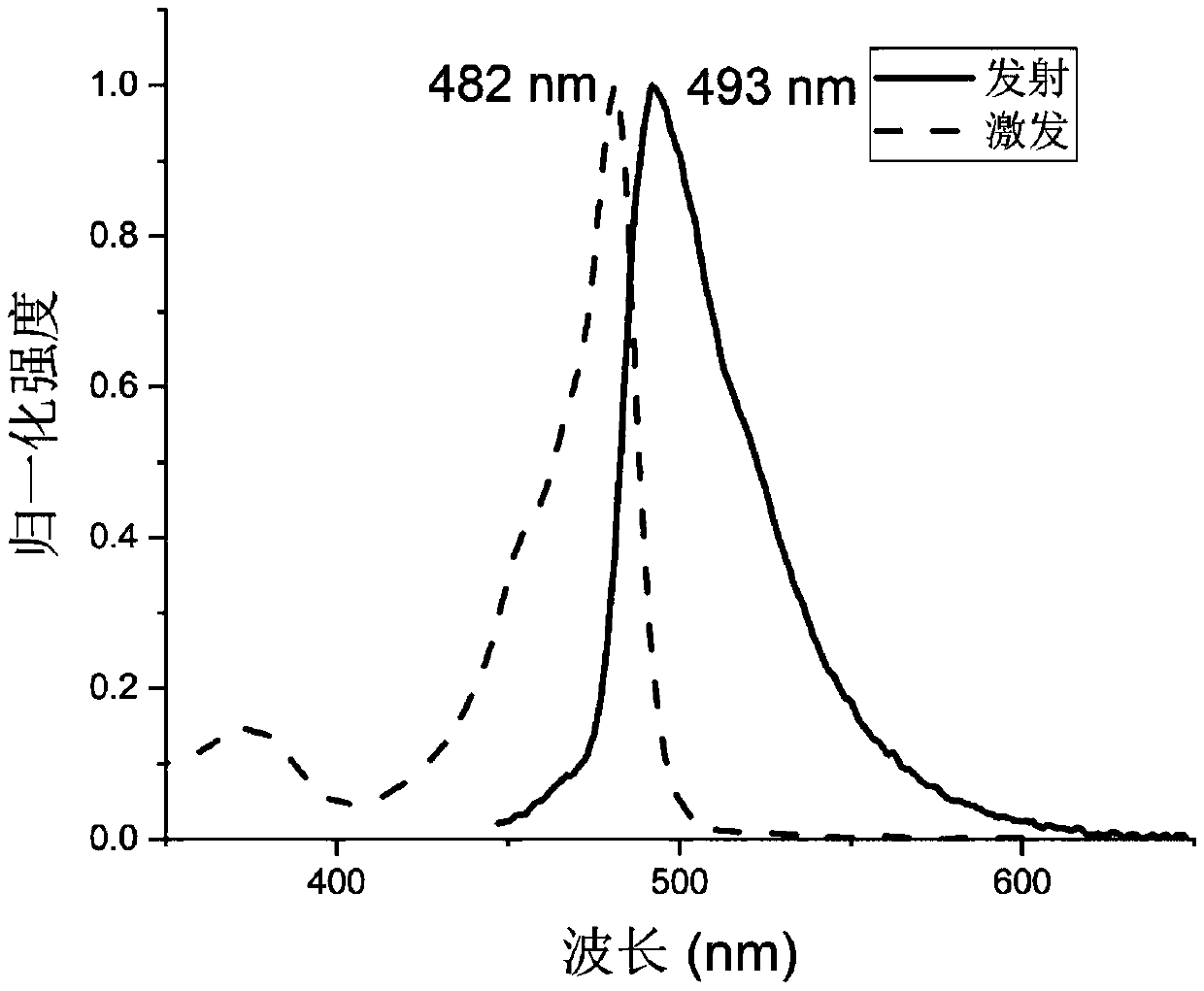488 nm excited no-clean Halo-tag probe as well as synthesis and biological application thereof
A 488nm probe technology, applied in the field of protein labeling, can solve the problems of poor signal-to-noise in fluorescence imaging, low cell permeability, and fluorescence signal errors, and achieve the effects of high photostability, simple purification, and high brightness
- Summary
- Abstract
- Description
- Claims
- Application Information
AI Technical Summary
Problems solved by technology
Method used
Image
Examples
Embodiment 1
[0041] Synthetic method of Halo-tag probe (Halo-DAze).
[0042] Synthesis of intermediate N-(2-(2-hydroxy)-ethoxy)ethyl-4-bromo-5-nitro-1,8-naphthalimide (OAN-NBr):
[0043]
[0044] 4-Bromo-5-nitro-1,8-naphthalimide (2.00 g, 6.24 mmol) was dissolved in 80 mL of ethanol, and diglycolamine (1.97 g, 18.7 mmol) was added dropwise thereto. After 2 hours at 70°C, the solvent was distilled off under reduced pressure, and the residue was separated through a silica gel column (petroleum ether:dichloromethane=3-1:1, V / V) to obtain 996 mg of off-white solid with a yield of 39%. Its nuclear magnetic spectrum proton spectrum and carbon spectrum data are as follows:
[0045] 1 H NMR (400MHz, CDCl 3 / DMSO -d 6 )δ8.70(d, J=7.8Hz, 1H), 8.50(d, J=7.9Hz, 1H), 8.28(d, J=7.9Hz, 1H), 8.13(d, J=7.8Hz, 1H) ,4.37(t,J=5.9Hz,2H),4.21(s,1H),3.78(t,J=5.9Hz,2H),3.58(s,4H).
[0046] 13 C NMR (101MHz, CDCl 3 / DMSO) δ167.48, 166.76, 155.77, 140.86, 137.11, 136.25, 135.21, 130.44, 128.84, 128.34, 12...
Embodiment 2
[0067] Synthetic method of Halo-tag probe (Halo-DAze).
[0068] Synthesis of intermediate N-(2-(2-hydroxy)-ethoxy)ethyl-4-bromo-5-nitro-1,8-naphthalimide (OAN-NBr):
[0069]
[0070] 4-Bromo-5-nitro-1,8-naphthalimide (1.75 g, 5.45 mmol) was dissolved in 35 mL of ethanol, and diglycolamine (0.58 g, 5.55 mmol) was added dropwise thereto. After 10 h at 40°C, the solvent was distilled off under reduced pressure, and the residue was separated through a silica gel column (petroleum ether:dichloromethane=3-1:1, V / V) to obtain 756 mg of off-white solid with a yield of 34%.
[0071] Synthesis of intermediate N-(2-(2-hydroxy)-ethoxy)ethyl-4,5-diazetidinyl-1,8-naphthalimide (Halo-OH):
[0072]
[0073] The intermediate OAN-Br (75 mg, 0.18 mmol) was dissolved in 7.5 mL of ethylene glycol methyl ether, and azetidine (25 mg, 0.44 mmol) was added thereto. The reaction solution was slowly heated to 50°C and reacted for 24h. Ethylene glycol methyl ether was removed under reduced press...
Embodiment 3
[0080] Synthetic method of Halo-tag probe (Halo-DAze).
[0081] Synthesis of intermediate N-(2-(2-hydroxy)-ethoxy)ethyl-4-bromo-5-nitro-1,8-naphthalimide (OAN-NBr):
[0082]
[0083] 4-Bromo-5-nitro-1,8-naphthalimide (2.25 g, 7.02 mmol) was dissolved in 225 mL of ethanol, and diglycolamine (9.0 g, 85.2 mmol) was added dropwise thereto. After 1 h at 90°C, the solvent was distilled off under reduced pressure, and the residue was separated through a silica gel column (petroleum ether: dichloromethane = 3-1:1, V / V) to obtain 1.044 g of off-white solid with a yield of 31%.
[0084] Synthesis of intermediate N-(2-(2-hydroxy)-ethoxy)ethyl-4,5-diazetidinyl-1,8-naphthalimide (Halo-OH):
[0085]
[0086] The intermediate OAN-Br (100 mg, 0.24 mmol) was dissolved in 60 mL of ethylene glycol methyl ether, and azetidine (900 mg, 15.7 mmol) was added thereto. The reaction solution was slowly heated to 140°C and reacted for 12h. Ethylene glycol methyl ether was removed under reduced ...
PUM
 Login to View More
Login to View More Abstract
Description
Claims
Application Information
 Login to View More
Login to View More - R&D
- Intellectual Property
- Life Sciences
- Materials
- Tech Scout
- Unparalleled Data Quality
- Higher Quality Content
- 60% Fewer Hallucinations
Browse by: Latest US Patents, China's latest patents, Technical Efficacy Thesaurus, Application Domain, Technology Topic, Popular Technical Reports.
© 2025 PatSnap. All rights reserved.Legal|Privacy policy|Modern Slavery Act Transparency Statement|Sitemap|About US| Contact US: help@patsnap.com



